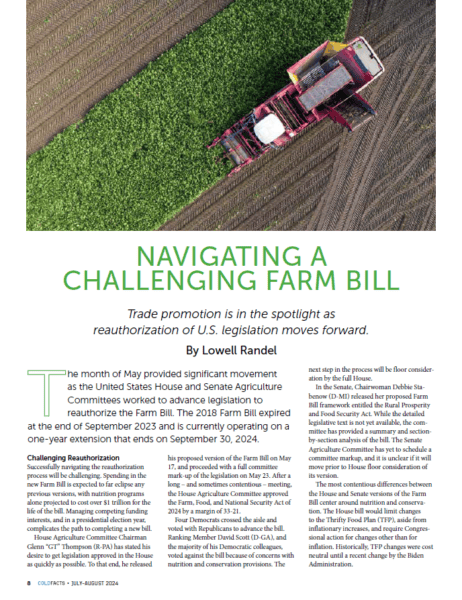From COLD FACTS Magazine (Click Image)
Read Below:
Navigating A Challenging Farm Bill
Trade promotion is in the spotlight as reauthorization of U.S. legislation moves forward.
By Lowell Randel
The month of May provided significant movement as the United States House and Senate Agriculture Committees worked to advance legislation to reauthorize the Farm Bill. The 2018 Farm Bill expired at the end of September 2023 and is currently operating on a one-year extension that ends on September 30, 2024.
Challenging Reauthorization
Successfully navigating the reauthorization process will be challenging. Spending in the new Farm Bill is expected to far eclipse any previous versions, with nutrition programs alone projected to cost over $1 trillion for the life of the bill. Managing competing funding interests, and in a presidential election year, complicates the path to completing a new bill.
House Agriculture Committee Chairman Glenn “GT” Thompson (R-PA) has stated his desire to get legislation approved in the House as quickly as possible. To that end, he released his proposed version of the Farm Bill on May 17, and proceeded with a full committee mark-up of the legislation on May 23. After a long – and sometimes contentious – meeting, the House Agriculture Committee approved the Farm, Food, and Nation Security Act of 2024 by a margin of 33-21.
Four Democrats crossed the aisle and voted with Republicans to advance the bill. Ranking Member David Scott (D-GA), and the majority of his Democratic colleagues, voted against the bill because of concerns with nutrition and conservation provisions. The next step in the process will be floor consideration by the full House.
In the Senate, Chairwoman Debbie Stabenow (D-MI) released her proposed Farm Bill framework entitled the Rural Prosperity and Food Security Act. While the detailed legislative text is not yet available, the committee has provided a summary and section-by-section analysis of the bill. The Senate Agriculture Committee has yet to schedule a committee markup, and it is unclear if it will move prior to House floor consideration of its version.
The most contentious differences between the House and Senate versions of the Farm Bill center around nutrition and conservation. The House bill would limit changes to the Thrifty Food Plan (TFP), aside from inflationary increases, and require Congressional action for changes other than for inflation. Historically, TFP changes were cost neutral until a recent change by the Biden Administration.
Democrats strongly oppose these limitations and assert that they will amount to significant cuts to future benefits. In conservation, Democrats would like to use funding provided by the Inflation Reduction Act specifically for climate change programs, while Republicans favor using those funds for a broader spectrum of conservation initiatives.
Despite disagreements on nutrition and conservation policy, there are some areas of agreement.
One part of the bill that enjoys strong bipartisan support is the Trade Title. There is broad recognition that food and agricultural trade is critical for the economy, and strong trade promotion programs create market access and act as a catalyst for innovation and economic growth. Unfortunately, there is currently a troubling trend in with U.S. food and agricultural trade.
According to United States Department of Agriculture, in Fiscal Year 2022, the United States exported nearly $196 billion in agricultural goods. That figure decreased to $184.5 billion in Fiscal Year 2023 and is projected to further fall to $170.5 billion in 2024. As a result, it is estimated that there will be a $30 billion trade deficit in 2024, up from $21 billion last year. Policymakers from both chambers and both sides of the aisle, recognize these challenges and are stepping up in support of stronger trade promotion programs.
Two key trade programs in the Farm Bill are the Market Access Program (MAP) and Foreign Market Development (FMD) program. The House version of the Farm Bill would double funding for these critical programs that help mitigate global food insecurity while providing new markets for U.S. producers. The Senate version would extend the current investment levels for MAP and FMD.
Important to the cold chain, both the House and Senate versions include language from H.R. 4612/ S. 2570, the Fortifying Refrigeration Infrastructure and Developing Global Exports (FRIDGE) Act.
A major limiting factor to growing export markets for U.S. food and agriculture products is insufficient infrastructure capabilities. USDA’s current trade programs are focused on promoting specific commodities or products, all of which are reliant on a functioning supply chain.
The FRIDGE Act will complement USDA’s ongoing programs by establishing a mechanism focused on strengthening the global food supply chain by delivering needs assessments, training and technical assistance in developing markets.
Major benefits of the FRIDGE Act will include:
- Increasing export market potential for U.S. perishable products
- Reducing food loss and waste
- Improving food security and nutrition in emerging markets
GCCA greatly appreciates the leadership of FRIDGE Act sponsors and cosponsors in the House and Senate, and support from the committees, to include this important language in their respective versions of the Farm Bill.
GCCA looks forward to working closely with the committees and others in Congress as the Farm Bill process moves forward.




